Analyzing Vietnam's Strategies for Eradicating Extreme Poverty by 2030
VerifiedAdded on 2023/06/05
|9
|2613
|104
Essay
AI Summary
This essay delves into Vietnam's strategies for eradicating extreme poverty by 2030, examining the historical, cultural, and structural factors influencing its progress. It begins by highlighting the prevalence of poverty in Vietnam, particularly after the Vietnam War, and the government's subsequent efforts to address it. The essay then explores the impact of historical events, cultural nuances, and structural changes on poverty levels. A critical analysis of the government's implementation of Sustainable Development Goals (SDGs) is presented, focusing on the transition from a socio-economic to a market-oriented economy, the role of agriculture, and the challenges of rural poverty. The essay concludes by emphasizing the importance of targeted strategies and continued investment in key sectors to achieve the goal of poverty eradication by 2030. The assignment explores the influence of the west, cultural issues and the role of economic policies like Doi Moi process. The essay also critically analyses the role of SDGs and the shift from socio economic to market oriented economy in poverty reduction.

Running head: IMAGINING HEALTH IN SOCIAL AND CULTURAL CONTEXTS
IMAGINING HEALTH IN SOCIAL AND CULTURAL CONTEXTS
Name of the student
Name of the University
Author note
IMAGINING HEALTH IN SOCIAL AND CULTURAL CONTEXTS
Name of the student
Name of the University
Author note
Paraphrase This Document
Need a fresh take? Get an instant paraphrase of this document with our AI Paraphraser
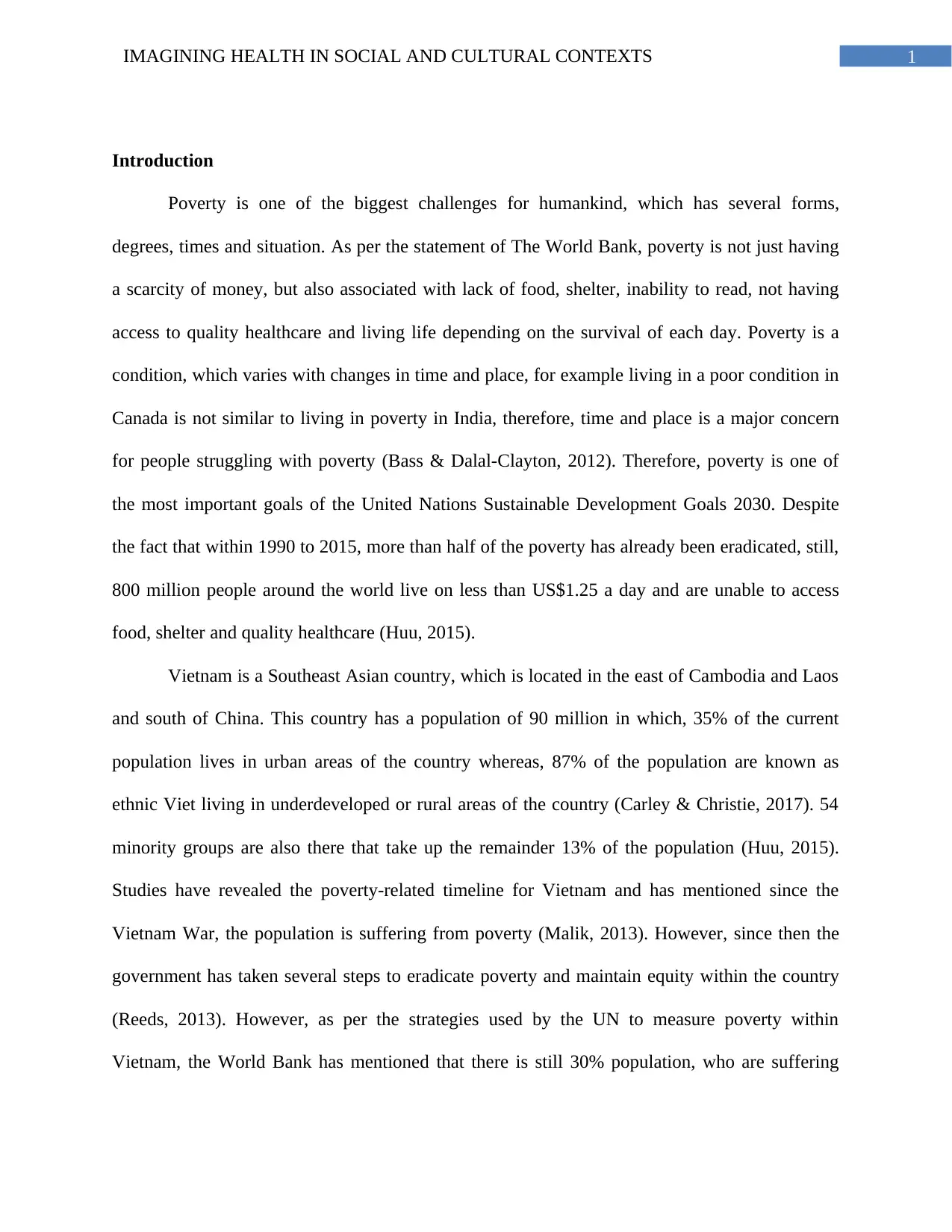
1IMAGINING HEALTH IN SOCIAL AND CULTURAL CONTEXTS
Introduction
Poverty is one of the biggest challenges for humankind, which has several forms,
degrees, times and situation. As per the statement of The World Bank, poverty is not just having
a scarcity of money, but also associated with lack of food, shelter, inability to read, not having
access to quality healthcare and living life depending on the survival of each day. Poverty is a
condition, which varies with changes in time and place, for example living in a poor condition in
Canada is not similar to living in poverty in India, therefore, time and place is a major concern
for people struggling with poverty (Bass & Dalal-Clayton, 2012). Therefore, poverty is one of
the most important goals of the United Nations Sustainable Development Goals 2030. Despite
the fact that within 1990 to 2015, more than half of the poverty has already been eradicated, still,
800 million people around the world live on less than US$1.25 a day and are unable to access
food, shelter and quality healthcare (Huu, 2015).
Vietnam is a Southeast Asian country, which is located in the east of Cambodia and Laos
and south of China. This country has a population of 90 million in which, 35% of the current
population lives in urban areas of the country whereas, 87% of the population are known as
ethnic Viet living in underdeveloped or rural areas of the country (Carley & Christie, 2017). 54
minority groups are also there that take up the remainder 13% of the population (Huu, 2015).
Studies have revealed the poverty-related timeline for Vietnam and has mentioned since the
Vietnam War, the population is suffering from poverty (Malik, 2013). However, since then the
government has taken several steps to eradicate poverty and maintain equity within the country
(Reeds, 2013). However, as per the strategies used by the UN to measure poverty within
Vietnam, the World Bank has mentioned that there is still 30% population, who are suffering
Introduction
Poverty is one of the biggest challenges for humankind, which has several forms,
degrees, times and situation. As per the statement of The World Bank, poverty is not just having
a scarcity of money, but also associated with lack of food, shelter, inability to read, not having
access to quality healthcare and living life depending on the survival of each day. Poverty is a
condition, which varies with changes in time and place, for example living in a poor condition in
Canada is not similar to living in poverty in India, therefore, time and place is a major concern
for people struggling with poverty (Bass & Dalal-Clayton, 2012). Therefore, poverty is one of
the most important goals of the United Nations Sustainable Development Goals 2030. Despite
the fact that within 1990 to 2015, more than half of the poverty has already been eradicated, still,
800 million people around the world live on less than US$1.25 a day and are unable to access
food, shelter and quality healthcare (Huu, 2015).
Vietnam is a Southeast Asian country, which is located in the east of Cambodia and Laos
and south of China. This country has a population of 90 million in which, 35% of the current
population lives in urban areas of the country whereas, 87% of the population are known as
ethnic Viet living in underdeveloped or rural areas of the country (Carley & Christie, 2017). 54
minority groups are also there that take up the remainder 13% of the population (Huu, 2015).
Studies have revealed the poverty-related timeline for Vietnam and has mentioned since the
Vietnam War, the population is suffering from poverty (Malik, 2013). However, since then the
government has taken several steps to eradicate poverty and maintain equity within the country
(Reeds, 2013). However, as per the strategies used by the UN to measure poverty within
Vietnam, the World Bank has mentioned that there is still 30% population, who are suffering
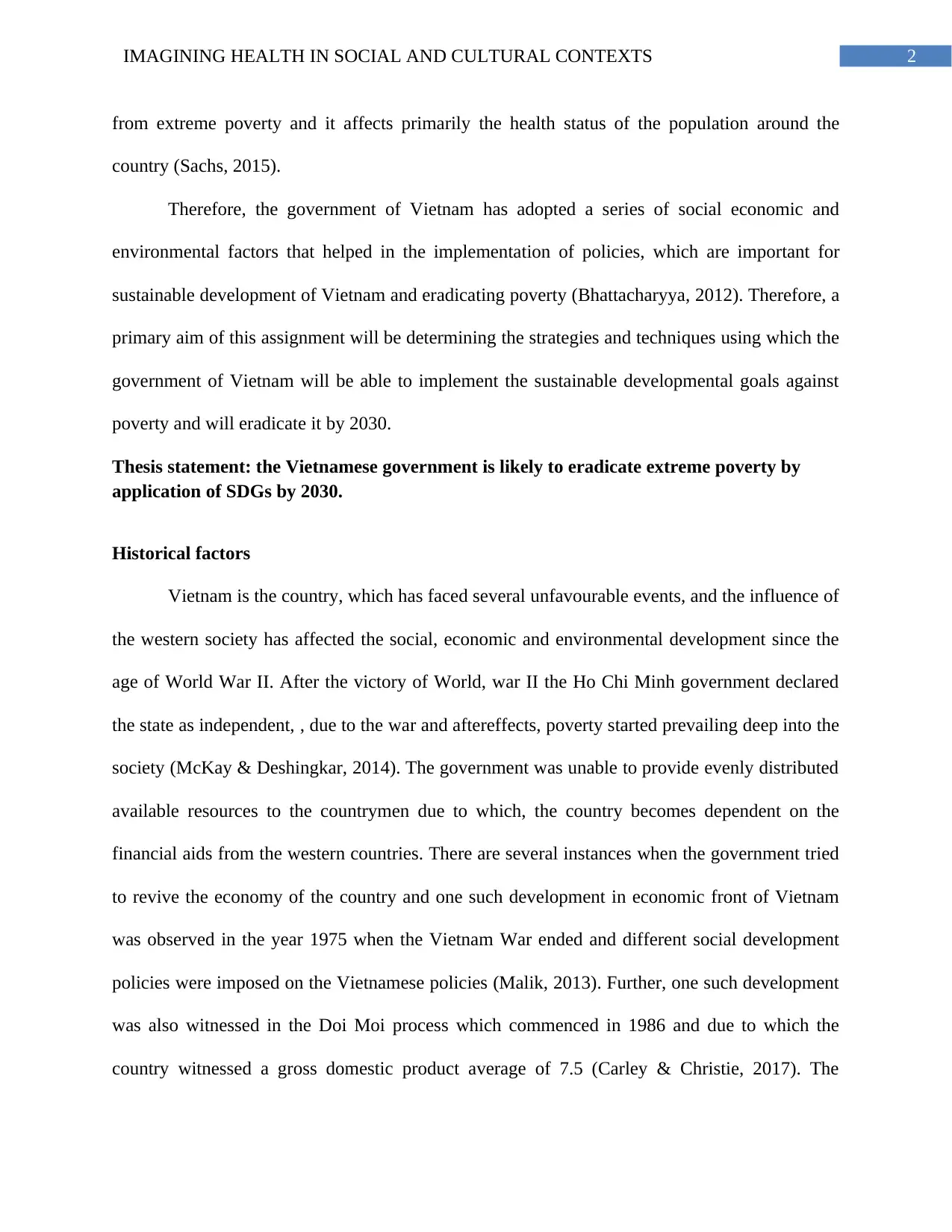
2IMAGINING HEALTH IN SOCIAL AND CULTURAL CONTEXTS
from extreme poverty and it affects primarily the health status of the population around the
country (Sachs, 2015).
Therefore, the government of Vietnam has adopted a series of social economic and
environmental factors that helped in the implementation of policies, which are important for
sustainable development of Vietnam and eradicating poverty (Bhattacharyya, 2012). Therefore, a
primary aim of this assignment will be determining the strategies and techniques using which the
government of Vietnam will be able to implement the sustainable developmental goals against
poverty and will eradicate it by 2030.
Thesis statement: the Vietnamese government is likely to eradicate extreme poverty by
application of SDGs by 2030.
Historical factors
Vietnam is the country, which has faced several unfavourable events, and the influence of
the western society has affected the social, economic and environmental development since the
age of World War II. After the victory of World, war II the Ho Chi Minh government declared
the state as independent, , due to the war and aftereffects, poverty started prevailing deep into the
society (McKay & Deshingkar, 2014). The government was unable to provide evenly distributed
available resources to the countrymen due to which, the country becomes dependent on the
financial aids from the western countries. There are several instances when the government tried
to revive the economy of the country and one such development in economic front of Vietnam
was observed in the year 1975 when the Vietnam War ended and different social development
policies were imposed on the Vietnamese policies (Malik, 2013). Further, one such development
was also witnessed in the Doi Moi process which commenced in 1986 and due to which the
country witnessed a gross domestic product average of 7.5 (Carley & Christie, 2017). The
from extreme poverty and it affects primarily the health status of the population around the
country (Sachs, 2015).
Therefore, the government of Vietnam has adopted a series of social economic and
environmental factors that helped in the implementation of policies, which are important for
sustainable development of Vietnam and eradicating poverty (Bhattacharyya, 2012). Therefore, a
primary aim of this assignment will be determining the strategies and techniques using which the
government of Vietnam will be able to implement the sustainable developmental goals against
poverty and will eradicate it by 2030.
Thesis statement: the Vietnamese government is likely to eradicate extreme poverty by
application of SDGs by 2030.
Historical factors
Vietnam is the country, which has faced several unfavourable events, and the influence of
the western society has affected the social, economic and environmental development since the
age of World War II. After the victory of World, war II the Ho Chi Minh government declared
the state as independent, , due to the war and aftereffects, poverty started prevailing deep into the
society (McKay & Deshingkar, 2014). The government was unable to provide evenly distributed
available resources to the countrymen due to which, the country becomes dependent on the
financial aids from the western countries. There are several instances when the government tried
to revive the economy of the country and one such development in economic front of Vietnam
was observed in the year 1975 when the Vietnam War ended and different social development
policies were imposed on the Vietnamese policies (Malik, 2013). Further, one such development
was also witnessed in the Doi Moi process which commenced in 1986 and due to which the
country witnessed a gross domestic product average of 7.5 (Carley & Christie, 2017). The
⊘ This is a preview!⊘
Do you want full access?
Subscribe today to unlock all pages.

Trusted by 1+ million students worldwide
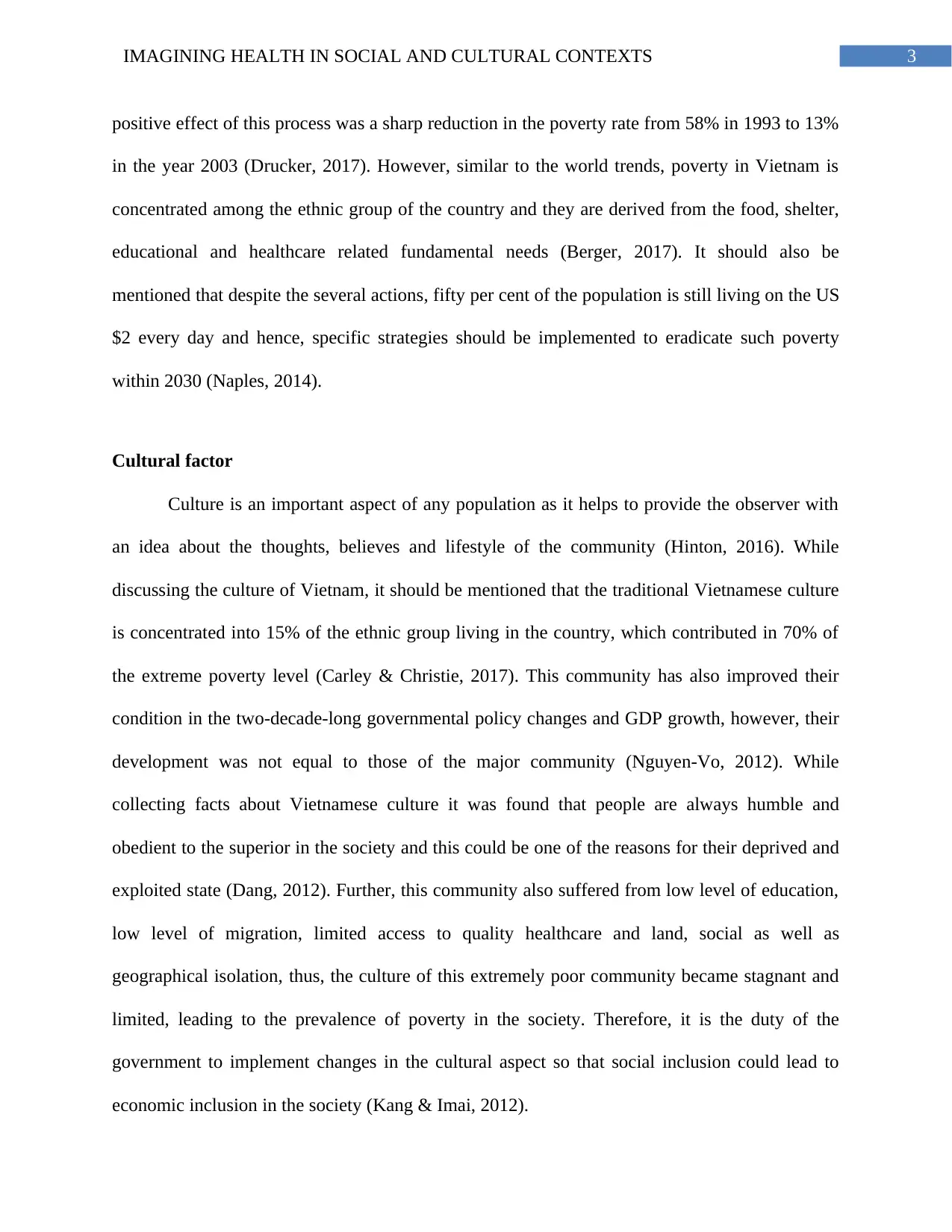
3IMAGINING HEALTH IN SOCIAL AND CULTURAL CONTEXTS
positive effect of this process was a sharp reduction in the poverty rate from 58% in 1993 to 13%
in the year 2003 (Drucker, 2017). However, similar to the world trends, poverty in Vietnam is
concentrated among the ethnic group of the country and they are derived from the food, shelter,
educational and healthcare related fundamental needs (Berger, 2017). It should also be
mentioned that despite the several actions, fifty per cent of the population is still living on the US
$2 every day and hence, specific strategies should be implemented to eradicate such poverty
within 2030 (Naples, 2014).
Cultural factor
Culture is an important aspect of any population as it helps to provide the observer with
an idea about the thoughts, believes and lifestyle of the community (Hinton, 2016). While
discussing the culture of Vietnam, it should be mentioned that the traditional Vietnamese culture
is concentrated into 15% of the ethnic group living in the country, which contributed in 70% of
the extreme poverty level (Carley & Christie, 2017). This community has also improved their
condition in the two-decade-long governmental policy changes and GDP growth, however, their
development was not equal to those of the major community (Nguyen-Vo, 2012). While
collecting facts about Vietnamese culture it was found that people are always humble and
obedient to the superior in the society and this could be one of the reasons for their deprived and
exploited state (Dang, 2012). Further, this community also suffered from low level of education,
low level of migration, limited access to quality healthcare and land, social as well as
geographical isolation, thus, the culture of this extremely poor community became stagnant and
limited, leading to the prevalence of poverty in the society. Therefore, it is the duty of the
government to implement changes in the cultural aspect so that social inclusion could lead to
economic inclusion in the society (Kang & Imai, 2012).
positive effect of this process was a sharp reduction in the poverty rate from 58% in 1993 to 13%
in the year 2003 (Drucker, 2017). However, similar to the world trends, poverty in Vietnam is
concentrated among the ethnic group of the country and they are derived from the food, shelter,
educational and healthcare related fundamental needs (Berger, 2017). It should also be
mentioned that despite the several actions, fifty per cent of the population is still living on the US
$2 every day and hence, specific strategies should be implemented to eradicate such poverty
within 2030 (Naples, 2014).
Cultural factor
Culture is an important aspect of any population as it helps to provide the observer with
an idea about the thoughts, believes and lifestyle of the community (Hinton, 2016). While
discussing the culture of Vietnam, it should be mentioned that the traditional Vietnamese culture
is concentrated into 15% of the ethnic group living in the country, which contributed in 70% of
the extreme poverty level (Carley & Christie, 2017). This community has also improved their
condition in the two-decade-long governmental policy changes and GDP growth, however, their
development was not equal to those of the major community (Nguyen-Vo, 2012). While
collecting facts about Vietnamese culture it was found that people are always humble and
obedient to the superior in the society and this could be one of the reasons for their deprived and
exploited state (Dang, 2012). Further, this community also suffered from low level of education,
low level of migration, limited access to quality healthcare and land, social as well as
geographical isolation, thus, the culture of this extremely poor community became stagnant and
limited, leading to the prevalence of poverty in the society. Therefore, it is the duty of the
government to implement changes in the cultural aspect so that social inclusion could lead to
economic inclusion in the society (Kang & Imai, 2012).
Paraphrase This Document
Need a fresh take? Get an instant paraphrase of this document with our AI Paraphraser
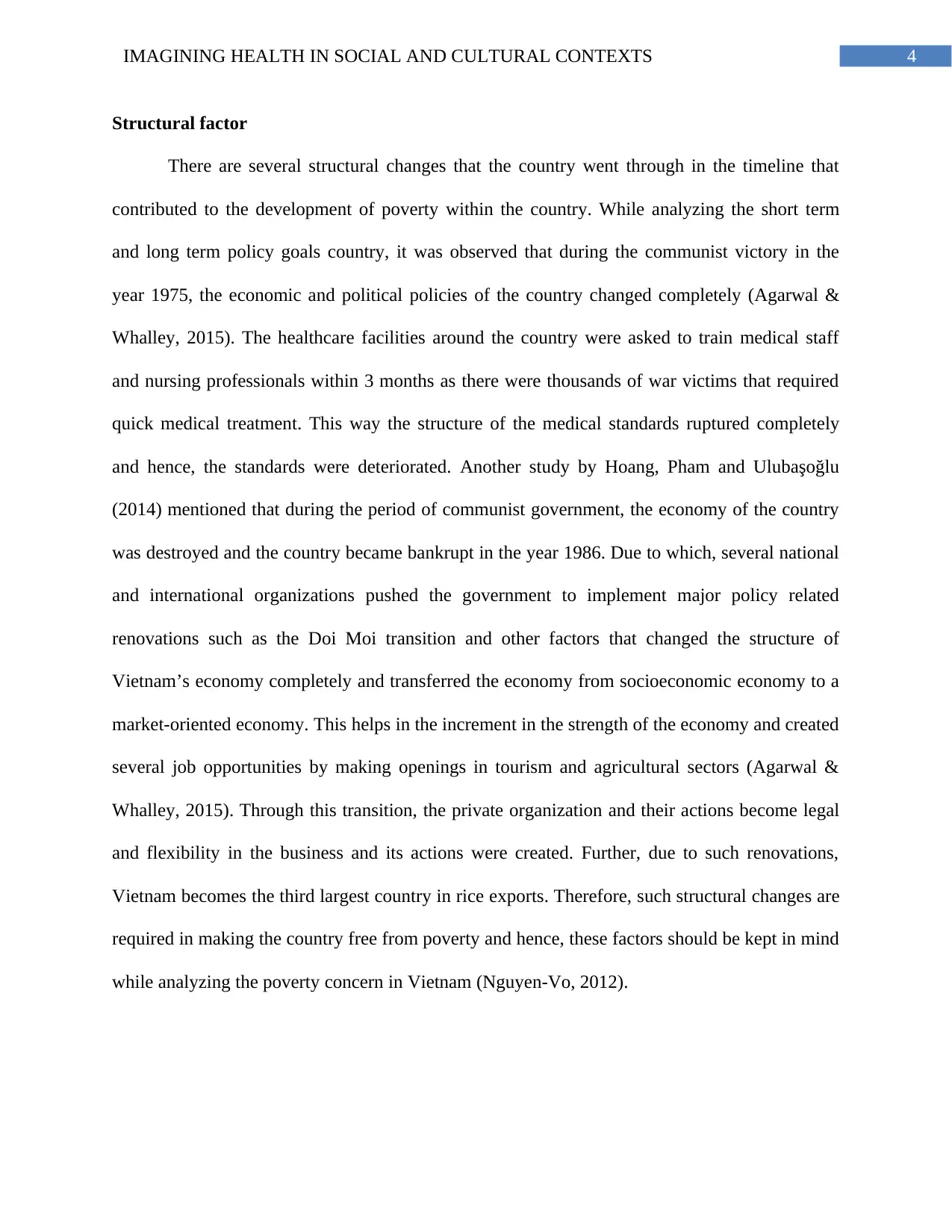
4IMAGINING HEALTH IN SOCIAL AND CULTURAL CONTEXTS
Structural factor
There are several structural changes that the country went through in the timeline that
contributed to the development of poverty within the country. While analyzing the short term
and long term policy goals country, it was observed that during the communist victory in the
year 1975, the economic and political policies of the country changed completely (Agarwal &
Whalley, 2015). The healthcare facilities around the country were asked to train medical staff
and nursing professionals within 3 months as there were thousands of war victims that required
quick medical treatment. This way the structure of the medical standards ruptured completely
and hence, the standards were deteriorated. Another study by Hoang, Pham and Ulubaşoğlu
(2014) mentioned that during the period of communist government, the economy of the country
was destroyed and the country became bankrupt in the year 1986. Due to which, several national
and international organizations pushed the government to implement major policy related
renovations such as the Doi Moi transition and other factors that changed the structure of
Vietnam’s economy completely and transferred the economy from socioeconomic economy to a
market-oriented economy. This helps in the increment in the strength of the economy and created
several job opportunities by making openings in tourism and agricultural sectors (Agarwal &
Whalley, 2015). Through this transition, the private organization and their actions become legal
and flexibility in the business and its actions were created. Further, due to such renovations,
Vietnam becomes the third largest country in rice exports. Therefore, such structural changes are
required in making the country free from poverty and hence, these factors should be kept in mind
while analyzing the poverty concern in Vietnam (Nguyen-Vo, 2012).
Structural factor
There are several structural changes that the country went through in the timeline that
contributed to the development of poverty within the country. While analyzing the short term
and long term policy goals country, it was observed that during the communist victory in the
year 1975, the economic and political policies of the country changed completely (Agarwal &
Whalley, 2015). The healthcare facilities around the country were asked to train medical staff
and nursing professionals within 3 months as there were thousands of war victims that required
quick medical treatment. This way the structure of the medical standards ruptured completely
and hence, the standards were deteriorated. Another study by Hoang, Pham and Ulubaşoğlu
(2014) mentioned that during the period of communist government, the economy of the country
was destroyed and the country became bankrupt in the year 1986. Due to which, several national
and international organizations pushed the government to implement major policy related
renovations such as the Doi Moi transition and other factors that changed the structure of
Vietnam’s economy completely and transferred the economy from socioeconomic economy to a
market-oriented economy. This helps in the increment in the strength of the economy and created
several job opportunities by making openings in tourism and agricultural sectors (Agarwal &
Whalley, 2015). Through this transition, the private organization and their actions become legal
and flexibility in the business and its actions were created. Further, due to such renovations,
Vietnam becomes the third largest country in rice exports. Therefore, such structural changes are
required in making the country free from poverty and hence, these factors should be kept in mind
while analyzing the poverty concern in Vietnam (Nguyen-Vo, 2012).
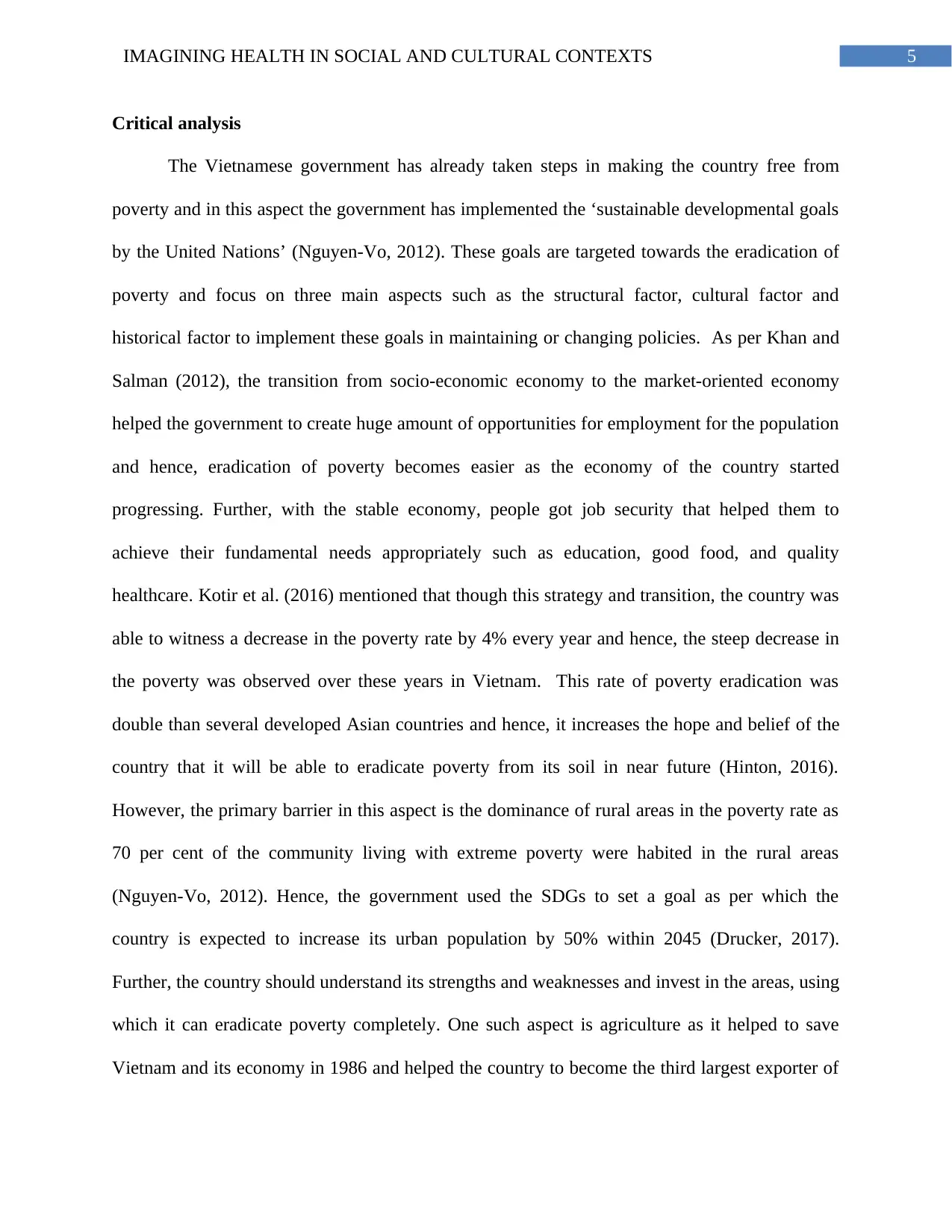
5IMAGINING HEALTH IN SOCIAL AND CULTURAL CONTEXTS
Critical analysis
The Vietnamese government has already taken steps in making the country free from
poverty and in this aspect the government has implemented the ‘sustainable developmental goals
by the United Nations’ (Nguyen-Vo, 2012). These goals are targeted towards the eradication of
poverty and focus on three main aspects such as the structural factor, cultural factor and
historical factor to implement these goals in maintaining or changing policies. As per Khan and
Salman (2012), the transition from socio-economic economy to the market-oriented economy
helped the government to create huge amount of opportunities for employment for the population
and hence, eradication of poverty becomes easier as the economy of the country started
progressing. Further, with the stable economy, people got job security that helped them to
achieve their fundamental needs appropriately such as education, good food, and quality
healthcare. Kotir et al. (2016) mentioned that though this strategy and transition, the country was
able to witness a decrease in the poverty rate by 4% every year and hence, the steep decrease in
the poverty was observed over these years in Vietnam. This rate of poverty eradication was
double than several developed Asian countries and hence, it increases the hope and belief of the
country that it will be able to eradicate poverty from its soil in near future (Hinton, 2016).
However, the primary barrier in this aspect is the dominance of rural areas in the poverty rate as
70 per cent of the community living with extreme poverty were habited in the rural areas
(Nguyen-Vo, 2012). Hence, the government used the SDGs to set a goal as per which the
country is expected to increase its urban population by 50% within 2045 (Drucker, 2017).
Further, the country should understand its strengths and weaknesses and invest in the areas, using
which it can eradicate poverty completely. One such aspect is agriculture as it helped to save
Vietnam and its economy in 1986 and helped the country to become the third largest exporter of
Critical analysis
The Vietnamese government has already taken steps in making the country free from
poverty and in this aspect the government has implemented the ‘sustainable developmental goals
by the United Nations’ (Nguyen-Vo, 2012). These goals are targeted towards the eradication of
poverty and focus on three main aspects such as the structural factor, cultural factor and
historical factor to implement these goals in maintaining or changing policies. As per Khan and
Salman (2012), the transition from socio-economic economy to the market-oriented economy
helped the government to create huge amount of opportunities for employment for the population
and hence, eradication of poverty becomes easier as the economy of the country started
progressing. Further, with the stable economy, people got job security that helped them to
achieve their fundamental needs appropriately such as education, good food, and quality
healthcare. Kotir et al. (2016) mentioned that though this strategy and transition, the country was
able to witness a decrease in the poverty rate by 4% every year and hence, the steep decrease in
the poverty was observed over these years in Vietnam. This rate of poverty eradication was
double than several developed Asian countries and hence, it increases the hope and belief of the
country that it will be able to eradicate poverty from its soil in near future (Hinton, 2016).
However, the primary barrier in this aspect is the dominance of rural areas in the poverty rate as
70 per cent of the community living with extreme poverty were habited in the rural areas
(Nguyen-Vo, 2012). Hence, the government used the SDGs to set a goal as per which the
country is expected to increase its urban population by 50% within 2045 (Drucker, 2017).
Further, the country should understand its strengths and weaknesses and invest in the areas, using
which it can eradicate poverty completely. One such aspect is agriculture as it helped to save
Vietnam and its economy in 1986 and helped the country to become the third largest exporter of
⊘ This is a preview!⊘
Do you want full access?
Subscribe today to unlock all pages.

Trusted by 1+ million students worldwide
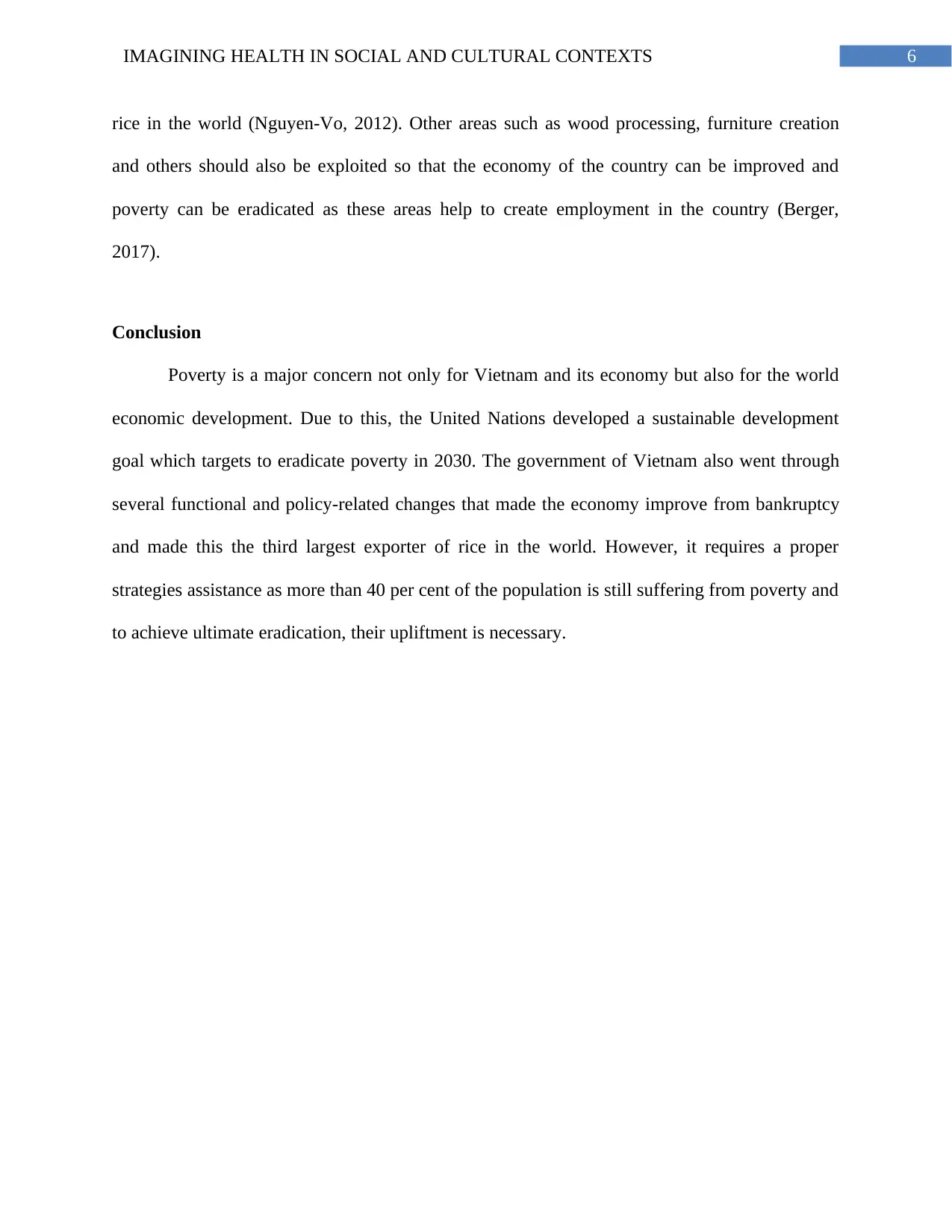
6IMAGINING HEALTH IN SOCIAL AND CULTURAL CONTEXTS
rice in the world (Nguyen-Vo, 2012). Other areas such as wood processing, furniture creation
and others should also be exploited so that the economy of the country can be improved and
poverty can be eradicated as these areas help to create employment in the country (Berger,
2017).
Conclusion
Poverty is a major concern not only for Vietnam and its economy but also for the world
economic development. Due to this, the United Nations developed a sustainable development
goal which targets to eradicate poverty in 2030. The government of Vietnam also went through
several functional and policy-related changes that made the economy improve from bankruptcy
and made this the third largest exporter of rice in the world. However, it requires a proper
strategies assistance as more than 40 per cent of the population is still suffering from poverty and
to achieve ultimate eradication, their upliftment is necessary.
rice in the world (Nguyen-Vo, 2012). Other areas such as wood processing, furniture creation
and others should also be exploited so that the economy of the country can be improved and
poverty can be eradicated as these areas help to create employment in the country (Berger,
2017).
Conclusion
Poverty is a major concern not only for Vietnam and its economy but also for the world
economic development. Due to this, the United Nations developed a sustainable development
goal which targets to eradicate poverty in 2030. The government of Vietnam also went through
several functional and policy-related changes that made the economy improve from bankruptcy
and made this the third largest exporter of rice in the world. However, it requires a proper
strategies assistance as more than 40 per cent of the population is still suffering from poverty and
to achieve ultimate eradication, their upliftment is necessary.
Paraphrase This Document
Need a fresh take? Get an instant paraphrase of this document with our AI Paraphraser
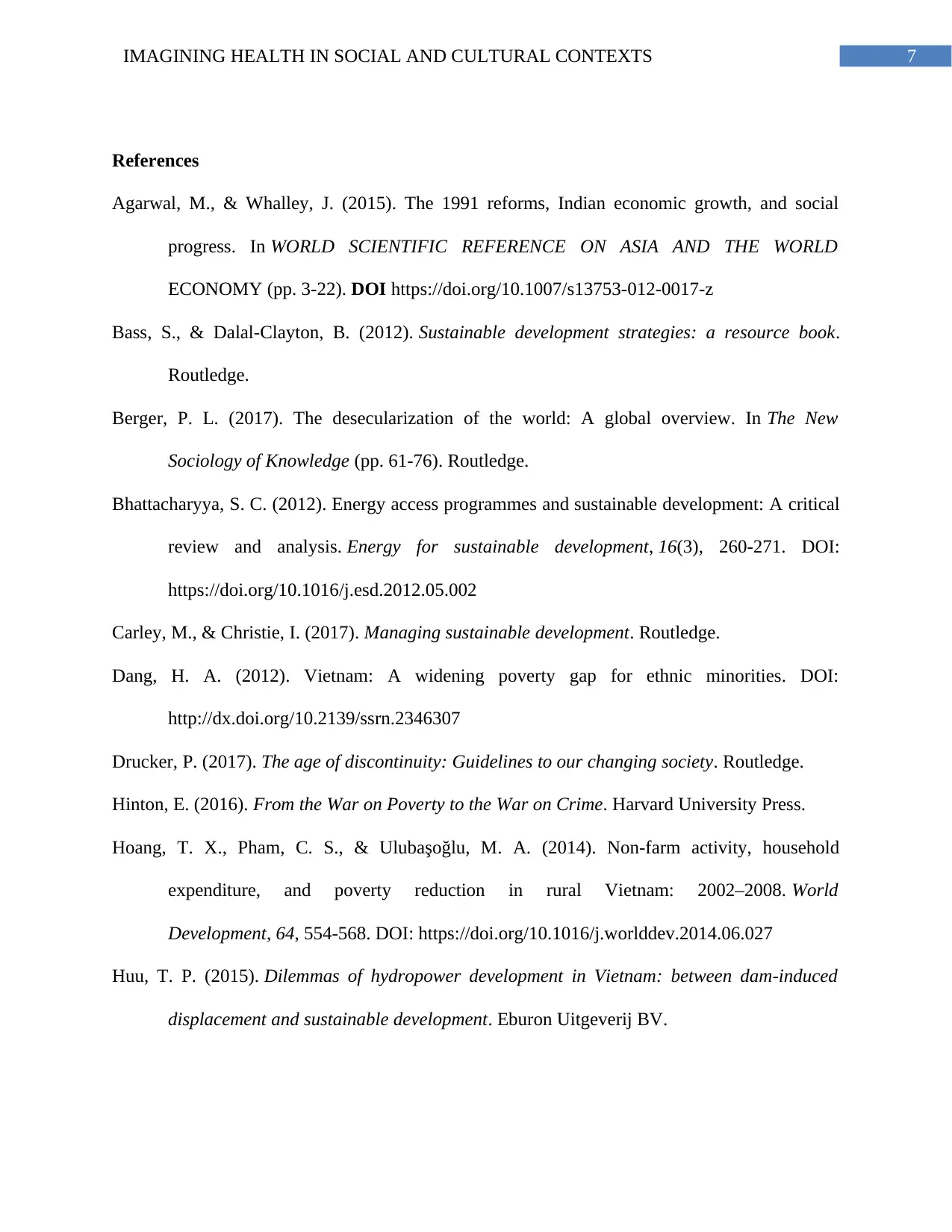
7IMAGINING HEALTH IN SOCIAL AND CULTURAL CONTEXTS
References
Agarwal, M., & Whalley, J. (2015). The 1991 reforms, Indian economic growth, and social
progress. In WORLD SCIENTIFIC REFERENCE ON ASIA AND THE WORLD
ECONOMY (pp. 3-22). DOI https://doi.org/10.1007/s13753-012-0017-z
Bass, S., & Dalal-Clayton, B. (2012). Sustainable development strategies: a resource book.
Routledge.
Berger, P. L. (2017). The desecularization of the world: A global overview. In The New
Sociology of Knowledge (pp. 61-76). Routledge.
Bhattacharyya, S. C. (2012). Energy access programmes and sustainable development: A critical
review and analysis. Energy for sustainable development, 16(3), 260-271. DOI:
https://doi.org/10.1016/j.esd.2012.05.002
Carley, M., & Christie, I. (2017). Managing sustainable development. Routledge.
Dang, H. A. (2012). Vietnam: A widening poverty gap for ethnic minorities. DOI:
http://dx.doi.org/10.2139/ssrn.2346307
Drucker, P. (2017). The age of discontinuity: Guidelines to our changing society. Routledge.
Hinton, E. (2016). From the War on Poverty to the War on Crime. Harvard University Press.
Hoang, T. X., Pham, C. S., & Ulubaşoğlu, M. A. (2014). Non-farm activity, household
expenditure, and poverty reduction in rural Vietnam: 2002–2008. World
Development, 64, 554-568. DOI: https://doi.org/10.1016/j.worlddev.2014.06.027
Huu, T. P. (2015). Dilemmas of hydropower development in Vietnam: between dam-induced
displacement and sustainable development. Eburon Uitgeverij BV.
References
Agarwal, M., & Whalley, J. (2015). The 1991 reforms, Indian economic growth, and social
progress. In WORLD SCIENTIFIC REFERENCE ON ASIA AND THE WORLD
ECONOMY (pp. 3-22). DOI https://doi.org/10.1007/s13753-012-0017-z
Bass, S., & Dalal-Clayton, B. (2012). Sustainable development strategies: a resource book.
Routledge.
Berger, P. L. (2017). The desecularization of the world: A global overview. In The New
Sociology of Knowledge (pp. 61-76). Routledge.
Bhattacharyya, S. C. (2012). Energy access programmes and sustainable development: A critical
review and analysis. Energy for sustainable development, 16(3), 260-271. DOI:
https://doi.org/10.1016/j.esd.2012.05.002
Carley, M., & Christie, I. (2017). Managing sustainable development. Routledge.
Dang, H. A. (2012). Vietnam: A widening poverty gap for ethnic minorities. DOI:
http://dx.doi.org/10.2139/ssrn.2346307
Drucker, P. (2017). The age of discontinuity: Guidelines to our changing society. Routledge.
Hinton, E. (2016). From the War on Poverty to the War on Crime. Harvard University Press.
Hoang, T. X., Pham, C. S., & Ulubaşoğlu, M. A. (2014). Non-farm activity, household
expenditure, and poverty reduction in rural Vietnam: 2002–2008. World
Development, 64, 554-568. DOI: https://doi.org/10.1016/j.worlddev.2014.06.027
Huu, T. P. (2015). Dilemmas of hydropower development in Vietnam: between dam-induced
displacement and sustainable development. Eburon Uitgeverij BV.
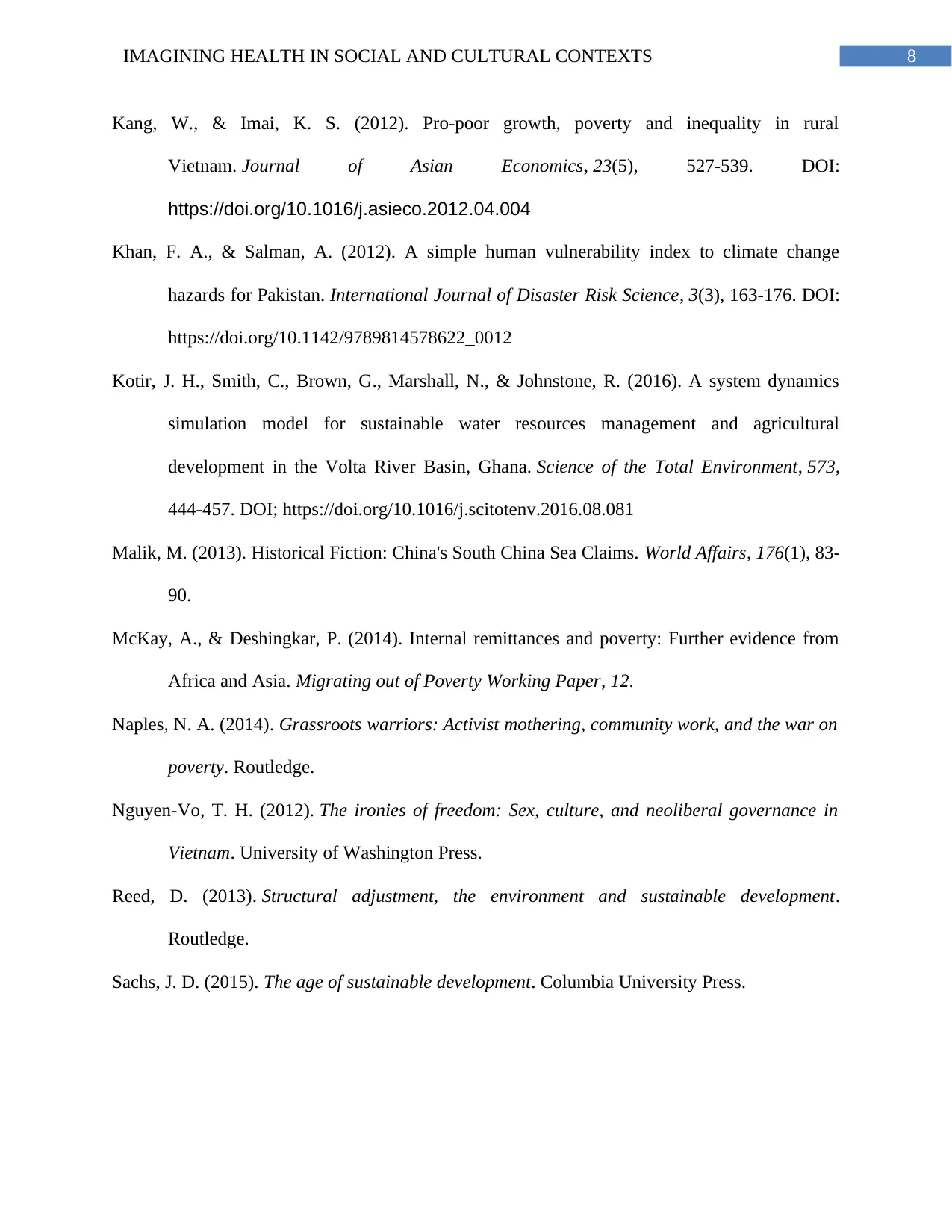
8IMAGINING HEALTH IN SOCIAL AND CULTURAL CONTEXTS
Kang, W., & Imai, K. S. (2012). Pro-poor growth, poverty and inequality in rural
Vietnam. Journal of Asian Economics, 23(5), 527-539. DOI:
https://doi.org/10.1016/j.asieco.2012.04.004
Khan, F. A., & Salman, A. (2012). A simple human vulnerability index to climate change
hazards for Pakistan. International Journal of Disaster Risk Science, 3(3), 163-176. DOI:
https://doi.org/10.1142/9789814578622_0012
Kotir, J. H., Smith, C., Brown, G., Marshall, N., & Johnstone, R. (2016). A system dynamics
simulation model for sustainable water resources management and agricultural
development in the Volta River Basin, Ghana. Science of the Total Environment, 573,
444-457. DOI; https://doi.org/10.1016/j.scitotenv.2016.08.081
Malik, M. (2013). Historical Fiction: China's South China Sea Claims. World Affairs, 176(1), 83-
90.
McKay, A., & Deshingkar, P. (2014). Internal remittances and poverty: Further evidence from
Africa and Asia. Migrating out of Poverty Working Paper, 12.
Naples, N. A. (2014). Grassroots warriors: Activist mothering, community work, and the war on
poverty. Routledge.
Nguyen-Vo, T. H. (2012). The ironies of freedom: Sex, culture, and neoliberal governance in
Vietnam. University of Washington Press.
Reed, D. (2013). Structural adjustment, the environment and sustainable development.
Routledge.
Sachs, J. D. (2015). The age of sustainable development. Columbia University Press.
Kang, W., & Imai, K. S. (2012). Pro-poor growth, poverty and inequality in rural
Vietnam. Journal of Asian Economics, 23(5), 527-539. DOI:
https://doi.org/10.1016/j.asieco.2012.04.004
Khan, F. A., & Salman, A. (2012). A simple human vulnerability index to climate change
hazards for Pakistan. International Journal of Disaster Risk Science, 3(3), 163-176. DOI:
https://doi.org/10.1142/9789814578622_0012
Kotir, J. H., Smith, C., Brown, G., Marshall, N., & Johnstone, R. (2016). A system dynamics
simulation model for sustainable water resources management and agricultural
development in the Volta River Basin, Ghana. Science of the Total Environment, 573,
444-457. DOI; https://doi.org/10.1016/j.scitotenv.2016.08.081
Malik, M. (2013). Historical Fiction: China's South China Sea Claims. World Affairs, 176(1), 83-
90.
McKay, A., & Deshingkar, P. (2014). Internal remittances and poverty: Further evidence from
Africa and Asia. Migrating out of Poverty Working Paper, 12.
Naples, N. A. (2014). Grassroots warriors: Activist mothering, community work, and the war on
poverty. Routledge.
Nguyen-Vo, T. H. (2012). The ironies of freedom: Sex, culture, and neoliberal governance in
Vietnam. University of Washington Press.
Reed, D. (2013). Structural adjustment, the environment and sustainable development.
Routledge.
Sachs, J. D. (2015). The age of sustainable development. Columbia University Press.
⊘ This is a preview!⊘
Do you want full access?
Subscribe today to unlock all pages.

Trusted by 1+ million students worldwide
1 out of 9
Related Documents
Your All-in-One AI-Powered Toolkit for Academic Success.
+13062052269
info@desklib.com
Available 24*7 on WhatsApp / Email
![[object Object]](/_next/static/media/star-bottom.7253800d.svg)
Unlock your academic potential
Copyright © 2020–2025 A2Z Services. All Rights Reserved. Developed and managed by ZUCOL.





